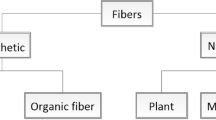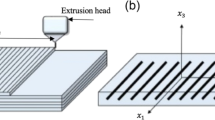Abstract
Injection moulding of polymer micro parts often affects the inner structure due to process conditions with reduced part dimensions. Consequently, ageing effects can increase with reduced part dimensions. This paper investigates the ageing effects in different scaled tensile bars, exemplarily injection moulded of polycarbonate. The results reveal during the here applied artificial ageing conditions the chemical ageing effects have less influence and primary physical ageing effects take place. A reduction of part dimensions leads to increasing impact of ageing effects for the here investigated polycarbonate.

















Similar content being viewed by others
References
Angelov AK, Coulter JP (2004) Micromolding product manufacture: a progress report. In: SPE Proceedings ANTEC, Chicago, pp 748–751
Batzer H (1985) Polymere Werkstoffe I. Chemie und Physik. Thieme, Stuttgart
Bibber DM (2004) Micro molding challenges. In: SPE Proceedings ANTEC, Chicago, pp 3703–3711
Dlubek G, Pionteck J, Shaikh M, Haeussler L, Thraenert S, Krause-Rehberg R (2007) The free volume in two untreated, pressure-densified, and CO2 gas exposed polymers from positron lifetime and pressure–volume–temperature experiments. e-Polymers 7:1–20
Dormann B, Juettner G (2009) High-precision miniatures. Kunststoffe Int 99:22–24
Drummer D, Ehrenstein GW, Hopmann C, Vetter K, Meister S, Fischer T, Piotter V, Prokop J (2012) Innovative process technologies for manufacturing thermoplastic micro parts—analysis and comparative assessment. J Plast Technol 8:439–467
Ehrenstein GW (2001) Polymeric materials: structure, properties, applications. Hanser, Munich
Ehrenstein GW, Pongratz S (2013) Resistance and stability of polymers. Hanser, Munich
Eloy JC (2011) Status of the MEMS industry. In: 5th EURIPIDES Forum Helsinki
Farrugia P, Vella P, Said L (2014) Design for micro insert moulding: a review. ASME Proc 45042:835–842. https://doi.org/10.1115/DETC2012-70571
Giboz J, Copponnex T, Mélé P (2007) Microinjection molding of thermoplastic polymers: a review. J Micromech Microeng 17:96–109. https://doi.org/10.1088/0960-1317/17/6/R02
Giboz J, Copponnex T, Mélé P (2009) Microinjection molding of thermoplastic polymers: morphological comparison with conventional injection molding. J Micromech Microeng 19:1–12. https://doi.org/10.1088/0960-1317/19/2/025023
Haberstroh E, Brandt M (2002) Determination of mechanical properties of thermoplastics suitable for micro systems. Macromol Math Eng 287:881–888. https://doi.org/10.1002/mame.200290023
Ho C, Vu-Khanh T (2003) Effects of time and temperature on physical aging of polycarbonate. Theor Appl Fract Mech 39:107–116. https://doi.org/10.1016/S0167-8442(02)00151-9
Jiang L, Zhou M, Ding Y, Zhou Y (2018) Aging induced ductile–brittle–ductile transition in bisphenol A polycarbonate. J Polym Res. https://doi.org/10.1007/s10965-018-1443-4
Jones A (1985) Molecular level model for motion and relaxation in glassy polycarbonate. Macromolecules 18:902–906
Jungmeier A (2010) Struktur und Eigenschaften spritzgegossener, thermoplastischer Mikroformteile. PhD thesis, University Erlangen-Nuernberg
Liu C (2007) Recent developments in polymer MEMS. Adv Mater 19:3783–3790. https://doi.org/10.1002/adma.200701709
Meister S (2016) Alterung spritzgegossener thermolastischer Mikrobauteile. PhD thesis, University Erlangen-Nuernberg
Meister S, Drummer D (2013) Influence of manufacturing conditions on measurement of mechanical material properties on thermoplastic micro tensile bars. Polym Testing 32:432–437. https://doi.org/10.1016/j.polymertesting.2012.12.006
Meister S, Jungmeier A, Drummer D (2012) Long term properties of injection moulded micro-parts. Macromol Mater Eng 297:994–1004. https://doi.org/10.1002/mame.201100379
Meister S, Seefried A, Drummer D (2016) Replication quality of micro structures in injection moulded thin wall parts using rapid tooling moulds. Microsyst Technol 22:687–698. https://doi.org/10.1007/s00542-015-2415-9
Michaeli W, Spennemann A, Gaertner R (2002) New plastification concepts for micro injection moulding. Microsyst Technol 8:55–57. https://doi.org/10.1016/j.polymertesting.2012.12.006
Rudolph N (2009) Druckverfestigung amorpher Thermoplaste. PhD thesis, University Erlangen-Nuernberg
Schmiederer D, Schmachtenberg E (2006) Einflüsse auf die Eigenschaften kleiner und dünnwandiger Spritzgussteile. J Plast Technol 2:1–21
Soloukhin V, Brokken-Zijp J, van Asselen O, de With G (2003) Physical aging of polycarbonate: elastic modulus, hardness, creep, endothermic peak, molecular weight distribution and infrared data. Macromolecules 36:7585–7597
Volynskii AL, Grokhovskaya T, Kulebyakina A, Bolshakova A, Bakeev N (2007) Visualization of structural rearrangements responsible for temperature-induced shrinkage of amorphous polycarbonate after its deformation at different conditions. Polym Sci Series A 49:1198–1209
Weidener H, Tilgner R (1980) Alterungsverhalten bei Kunststoffen-Charakterisierung von Alterungszuständen. Kunststoffe 70:837–844
White J (2006) Polymer ageing: physics, chemistry or engineering? Time to reflect. C R Chim 9:1396–1408. https://doi.org/10.1016/j.crci.2006.07.008
Yang C, Yin XH, Cheng GM (2013) Microinjection molding of microsystem components: new aspects in improving performance. J Micromech Microeng 23:1–21. https://doi.org/10.1088/0960-1317/23/9/093001
Acknowledgements
The author gratefully acknowledges the German Research Foundation (DFG) for funding the work in DR421/16-1. Special thanks also go to Prof. Dietmar Drummer and the Lehrstuhl für Kunststofftechnik of the University Erlangen-Nürnberg for supporting this work. The author also extends its gratitude to the industrial partners Arburg GmbH & Co. KG and Covestro AG for providing equipment and material.
Author information
Authors and Affiliations
Corresponding author
Additional information
Publisher's Note
Springer Nature remains neutral with regard to jurisdictional claims in published maps and institutional affiliations.
Rights and permissions
About this article
Cite this article
Meister, S. Influence of part dimension on ageing of injection moulded thermoplastic materials: exemplary studies on amorphous polycarbonate. Microsyst Technol 27, 2733–2743 (2021). https://doi.org/10.1007/s00542-020-05020-3
Received:
Accepted:
Published:
Issue Date:
DOI: https://doi.org/10.1007/s00542-020-05020-3




